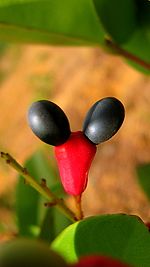Carpophor


When the Karpophor (φέρω Greek, φορέω "I Wear" and καρπός "fruit", so καρποφόρος karpophóros "fruit-bearing") or the Karpopodium (καρπός "fruit", πούς "foot", πόδιον "feet"), the fruit holder , fruit bodies referred in botany a stalk or an extension between the flower base and the pistil so that the ovary or the fruit is stalked longer than just the flower stalk. The border between the peduncle and the extension is the starting point of the perianth . It is mostly understood as the carrier of the partial fruits (merikarp) of a split fruit (schizocarp).
There is also the genus Carpopodium , with a few species, in the cruciferous family .
Emergence
It is mainly formed from the carpel and / or the flower base and is often equated with the gynophore and other stem-like extensions of the ovary or flower base that come from the flower base. However, it must be distinguished from it, although it is sometimes very difficult to differentiate. When the fruit ripens, the carpophore usually arises from the strong sclerenchymal cord, which is located in the central axis between the fruit leaves or otherwise from the base of the pistil and / or flower, e.g. B. by intercalary meristems .
Depending on the species, it is more or less developed. With some it is almost nonexistent.
In the composites , the carpopodium denotes the basal demolition zone, the anchor point of the fruit ( achenes ). There is a differently shaped, more or less hard "structure" ( callus , podocarp) below the ovary. This structure is to be regarded as different.

Occurrence
The role of the fruit keeper in umbellifers ( Apiaceae ) is mentioned particularly often . Here the carpophor appears as a two-legged carrier on which the fruit remains for a long time after it has disintegrated into two individual fruits. In the star umbel, however, it is no longer there. However, it also occurs in this form in some other plant families. In the case of carnations , it is just still there. In Ricinus communis there are three partial fruits, in the geraniums it forms a long column in the "beak", to which the stylus are attached and the ovaries of the split fruit sit below. Specifically, it is in the peanut which Erdbohne or Vigna subterranea (Erderbse) Here he pushes the legumes in the ground where they mature then.
Geranium rotundifolium with Karpophor and chipped part fruits to the bent-style parts or awns
Two-branch carpophor, the fruit holder of the double achenes, in Pimpinella anisum
Mushrooms
Also with mushrooms one speaks of a carpophor. It refers to the entire fruiting body (stem and hat, etc.) (mycocarp, sporophore ), i.e. the above-ground parts of large mushrooms.
Individual evidence
- ^ Neotropical Ochnaceae at KEW Royal Botanical Gardens, accessed May 29, 2018.
- ↑ Bruce G. Baldwin, Douglas H. Goldman, et al. a .: The Jepson Manual: Vascular Plants of California. Second Edition, University of California Press, 2012, ISBN 978-0-5202-5312-4 , p. 28.
- ↑ Eckehart J. Jäger (Ed.): Rothmaler - Exkursionsflora von Deutschland. 21st edition, Springer, 2016, ISBN 978-3-662-49708-1 , p. 881.
- ↑ H. Brücher: Tropical useful plants. Springer, 1977, ISBN 978-3-662-13238-8 (reprint), p. 159.
- ↑ WA Dayton: Glossary of Botanical Terms Commonly Used in Range Research. US Government Printing Office, 1950, p. 6.
- ↑ Th. CH Cole: Dictionary of Biology Dictionary of Biology: German / English. 4th edition, Springer, 2015, ISBN 978-3-642-55327-1 , p. 140.
- ^ Eötvös Loránd University : Annales: Sectio biologica. Volumes 5-8, 1962, pp. 196, 215.
- ^ Akadémiai Kiadó : Acta Botanica Hungarica. Volume 17, Part 1–2, 1971, pp. 190–206, online (PDF; 243 MB), at REAL-J - repository of the Library and Information Center, Hungarian Academy of Sciences, accessed on May 29, 2018.
- ↑ Apiaceae (umbelliferae) on biologie.uni-ulm.de, accessed on May 27, 2018.
- ^ A b Reinhard Lieberei, Christoph Reisdorff: Useful plants. 8th edition, Thieme, 2012, ISBN 978-3-13-530408-3 , p. 130.
- ↑ Nádia Roque, David J. Keil, Alfonso Susanna: Illustrated glossary of Compositae. 2009, in: VA Funk u. a .: Systematics, evolution, and biogeography of Compositae. International Association for Plant Taxonomy, University of Vienna, 2009, ISBN 978-3-9501754-3-1 , Appendix A, online (PDF) at researchgate.net, accessed May 29, 2018.
- ^ MZ Haque, MBE Godward: New records of the carpopodium in Compositae and its taxonomic use. In: Botanical Journal of the Linnean Society. 89, 1989, pp. 321-340, doi : 10.1111 / j.1095-8339.1984.tb02564.x .
- ^ Uni-Greifswald: Family: Apiaceae (umbellifers) ( Memento from March 25, 2016 in the Internet Archive ).
- ^ Karl Smalian : Basic features of the botany. Part 1: Flowering Plants , Freytag, 1910, Salzwasser, 2013, ISBN 978-3-8460-3256-5 (Reprint), p. 61 f, limited preview in the Google book search.
- ↑ Old trees with habitat structures (habitat trees) at the Federal Research Center for Forests, Snow and Landscape WSL, accessed on May 27, 2018.
- ^ Pavel Kalač: Edible Mushrooms. Academic Press, 2016, ISBN 978-0-12-804455-1 , p. 4 f, limited preview in Google book search.
- ^ Prakash Singh Bisen: Laboratory Protocols in Applied Life Sciences. CRC Press, 2014, ISBN 978-1-4665-5314-9 , p. 1432.








